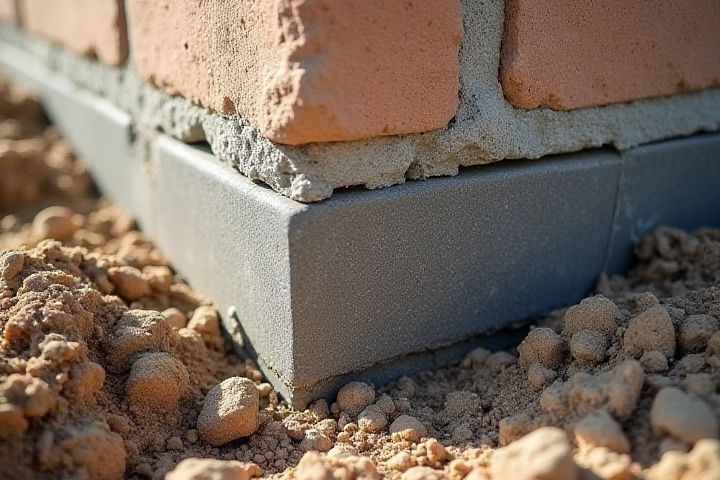
Repairing a house foundation involves several essential steps to ensure stability and safety. First, assess the extent of the damage by inspecting cracks, uneven floors, and doors that stick. You may need to dig around the foundation to expose the footing, allowing for a thorough examination and possible installation of piers or underpinning to reinforce the structure. Waterproofing the foundation is also crucial, so consider applying a sealant and ensuring proper drainage systems are in place to divert water away. Once the repair process is complete, monitor your foundation regularly for any signs of movement or damage to maintain its integrity over time.
How To Repair A House Foundation
Identify and assess foundation damage
Identifying and assessing foundation damage is crucial for effective repairs. Begin by examining cracks in walls and floors, as horizontal or stair-step cracks often indicate significant issues. Assess any noticeable shifts in doors or windows, which may reveal underlying foundation problems. Lastly, observe the surrounding landscape; improper drainage or soil erosion can exacerbate foundation distress, necessitating further evaluation and repair.
Determine the underlying cause of the issue
Identifying the underlying cause of foundation issues is crucial for effective repairs. Common factors include soil erosion, inadequate drainage, and tree root intrusion, which can lead to uneven settling or cracking. You should conduct a thorough inspection to find signs of water damage, such as dampness in your basement or mold growth, which indicate poor drainage systems. Once the cause is pinpointed, you can choose the appropriate repair method, such as underpinning, mudjacking, or installing drainage solutions, ensuring a stable foundation for your home.
Select the appropriate repair method
Selecting the appropriate repair method for a house foundation involves assessing the specific type of foundation damage you are facing, such as cracks, settling, or heaving. For minor cracks, epoxy injection or polyurethane foam may effectively seal the damaged areas, preventing further moisture intrusion. If your foundation is settling, underpinning techniques like helical piers or push piers can provide the necessary support and stabilize the structure. Properly identifying the cause of foundation issues, such as poor drainage or soil erosion, is crucial to ensure that the repair method you choose addresses the underlying problem.
Use hydraulic jacking for structural leveling
Use hydraulic jacking as an effective method for structural leveling when repairing a house foundation. This technique involves inserting hydraulic jacks beneath the foundation's support structures to raise the home to its proper height. Ensure to assess the load-bearing walls and piers before proceeding, as this preparation is crucial for successful leveling. After lifting, secure the foundation with new support piers or concrete blocks to maintain stability and prevent future settling.
Implement underpinning techniques
Implementing underpinning techniques is a crucial method for repairing a house foundation when settlement or structural issues occur. Common underpinning approaches include traditional mass concrete underpinning, where additional concrete is poured beneath the foundation to increase stability, as well as piering methods that utilize steel or concrete piers driven deep into the ground for robust support. Another option is slab jacking, which involves injecting a mixture beneath the foundation to lift and level it, addressing uneven surfaces. For optimal results, consulting a structural engineer is recommended to assess your specific situation and determine the best underpinning method for your foundation repair needs.
Seal or fill cracks to prevent leakage
Seal or fill cracks in your house foundation to effectively prevent water leakage and safeguard your home's structural integrity. Utilize high-quality sealants or injectable epoxy to fill any visible gaps, ensuring the materials are appropriate for your foundation type. Pay close attention to both vertical and horizontal cracks, which can indicate various underlying issues. Regularly inspect your foundation for new cracks or signs of water damage to maintain a healthy and secure home environment.
Address drainage problems around the foundation
Addressing drainage problems around your house foundation is crucial for preventing structural damage. Inspect the grading of your yard, ensuring it slopes away from the foundation to redirect water runoff effectively. Consider installing gutters and downspouts to channel rainwater away, preventing pooling near the base of your home. Also, integrating French drains or swales can further enhance drainage, protecting your foundation from the adverse effects of moisture accumulation.
Ensure proper soil stabilization
To ensure proper soil stabilization for your house foundation, start by assessing the soil type and moisture content around the foundation. Implement techniques such as deep compaction or soil injection, which can increase load-bearing capacity by up to 50%. If excavation is necessary, consider adding geotextiles or gravel drains to facilitate drainage and prevent water accumulation, reducing soil erosion risks. Maintaining consistent moisture levels through proper landscaping and drainage systems can also significantly enhance long-term stability and support for your foundation.
Consult with a structural engineer if needed
Consulting with a structural engineer is crucial when addressing house foundation problems, ensuring you receive expert guidance tailored to your specific issue. An engineer can assess the extent of any damage and recommend appropriate repair methods, which may include underpinning or slab jacking. Their expertise helps determine the cause of foundation issues, often linked to soil erosion, water intrusion, or settling, which can significantly impact long-term stability. By implementing their recommendations, you can effectively restore the integrity of your foundation, potentially increasing your property value and safety.
Monitor the foundation post-repair for further issues
After completing repairs on your house foundation, it's crucial to monitor it closely for any new issues. Inspect for signs of settling, such as cracks in walls or uneven floors, and check for moisture accumulation around the foundation. Regularly assess drainage systems to ensure proper water flow away from your property, as excessive moisture can weaken repairs. Aim for inspections at least twice a year, especially after heavy rain or significant temperature changes, to catch potential problems early.
